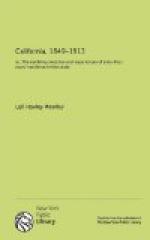Closing Chapter of Vigilance Committee.
As a closing chapter to the history of the Vigilance Committee of 1856, or at least the immediate cause of its coming into existence, there was sold at public auction in San Francisco on the evening of January 14th, 1913, the very papers that James King, of William, had had transcribed from the records in New York and published in his paper the “Evening Bulletin” showing the record of Casey’s indictment, imprisonment and pardon, the publication of which he, Casey, resented by shooting King. In addition to these documents were sold many of the books, papers, etc., of as well as other books and papers relating to the Vigilance Committee that had been collected together by Mr. C. J. King, a son of James King of William.
Vigilance Committee Work In 1849, ’50 and ’51.
While there has been a great deal said about the Vigilance Committee in California in 1856, there has not been much said about it in ’49, ’50 and ’51. That the reader may know what was going on up to that time, I must now draw largely from previously published accounts for my information, for a condensed statement.
On the 30th day of January, 1847, Mr. Washington A. Bartlet became the first Alcalde of San Francisco, under the American flag. At this time the population numbered 500, including Indians. During ’47 and ’48 it increased to two thousand, and by the last of July, 1849, it was over five thousand. The condition of the town at this time was terribly demoralized, gambling, drunkenness and fights on every corner. About this this came a class of offscourings of other countries and the curses to California. It was during this dreadful state of uncertainty that the famous Vigilance Committee of 1851 was organized, and it now became known that there was an organized committee for the purpose of dealing with criminals. It was about this time the case of John Jenkins came up and he was arrested and tried by the Committee, and condemned to be hanged. He was then hanged until he was dead. The tragic fate of Jenkins, and the determination manifested to deal severely with the villains had the effect of frightening many away. The steamers to Stockton and Sacramento were crowded with the flying rascals. The Sydney Coves and the more desperate characters remained. At this, time the city served notices on all persons known to be vicious characters to leave the city at once, on fear of being forcibly expelled to the places whence they had come. This was rigidly enforced and had a very wholesome effect.
The next one to come before the Committee was James Stuart, who was transported from England to Australia for forgery. It is not worth while to go into details on account of this man, for he confessed to crimes enough to hang him a dozen times. On the morning of July 11th, 1851, the taps on the bell of the Monumental Engine House summoned the entire Vigilance Committee. The prisoner was then allowed two hours




